Published Friday, November 25, 2005
 Credit card is one of the biggest inventions in this modern retail consumer society and a great advancement in the payment technology of the banking system since the invention of money. A tool that is very essential to the success and existence of any merchant whether it is a internet business , a physical store or both. Most people today carry a credit card for the convenience of not carrying cash, it is less bulky and light while others do so because of the purchasing power they have in their possession which they would not have had otherwise. Credit cards allows anyone to purchase any item that they desire (depending on their credit limit ) that they would not able to afford upfront. Credit card is one of the biggest inventions in this modern retail consumer society and a great advancement in the payment technology of the banking system since the invention of money. A tool that is very essential to the success and existence of any merchant whether it is a internet business , a physical store or both. Most people today carry a credit card for the convenience of not carrying cash, it is less bulky and light while others do so because of the purchasing power they have in their possession which they would not have had otherwise. Credit cards allows anyone to purchase any item that they desire (depending on their credit limit ) that they would not able to afford upfront.  Credit cards are well engineered for minimum thickness which results in it being light and less bulky, it can easily fit in a wallet (bill fold), purse, pocket or any other personal. It can also easily fit with other similar sized documents such as medical card and drivers license. So, have you ever stopped to think about the evolution of your credit card? I guess you did not. Well this article will explain the evolution of this “cash on plastic” that confidently let you purchase stuff without no money (cash) in your pocket. Credit cards are well engineered for minimum thickness which results in it being light and less bulky, it can easily fit in a wallet (bill fold), purse, pocket or any other personal. It can also easily fit with other similar sized documents such as medical card and drivers license. So, have you ever stopped to think about the evolution of your credit card? I guess you did not. Well this article will explain the evolution of this “cash on plastic” that confidently let you purchase stuff without no money (cash) in your pocket.
In 1914 there was credit system that was used by Western Union to give to their more prominent customers in the interest of good customer service. Prominent (prestigious) customers were given a metal card that was used to defer payments (interest free) on services used by them. This credit system was called “Metal Money”. In 1924 General Petroleum Corporation (an oil company) saw the success and being aware of the value of goodwill this could offer to their customers, also issued their own metal money for gasoline and automotive services. This was first offered to their employees followed by selected customers then the general public after its great success. During the 1920s and 1930s this form of credit card system spread to other companies such as Railroad, hotel chains, airline, oil companies and department stores. In the late 30’s American Telephone and Telegraph (AT&T) introduced their “credit card” called the Bell System Credit Card. The use of such “credit cards” greatly increased after World War II due to the rapid growth of businesses, increase in travel and the great demands for goods and services and thus, it popularity grows significantly.
A Sears Store Plate ............... and.............. A Common Store Plate
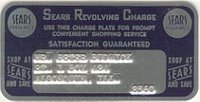 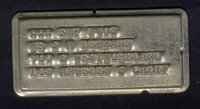
In 1950, the first universal credit card was introduced by Diners Club, Inc (invented by Diners' Club founder Frank McNamara). This was a new kind of credit card which set the foundation on which today’s card credit is established, unlike the other cards where they could only used for specific goods and services, the Diner Club had a more general use. It was first used by members for restaurant services but quickly expanded beyond that service to cover general travel and entertainment expenses thus covering a variety of establishments. Cardholders were charged an annual fee and billed on a monthly or yearly basis. During the 1950s, because of its convenience and efficiency, its popularity increased and many merchants were very eager to accept the card because customers spend a lot more than if it was cash since they can charge it to their cards.
In 1951 the first bank to implement this credit system was the Franklin National Bank in New York. Customers would submit an application for a loan and were screened for credit. Approved customers were then given a card (Charge-It card) to make retail purchases. This credit card system was similar to today’s system where consumers could made a purchase using the card at participating merchants. This merchant would copy the customers information from the unto a sales slip then obtain authorization from the bank thus, completing the purchase. The bank would then , in turn, reimburse this participating retailer and collect the debt from the consumer at a later date with a flat fee to cover the costs of providing this credit loan. This system was very successful and after a couple of years, other banks impressed with this credit system jumped on board and offered their customers similar services.
In 1958, the American Express Company (a traveler’s check business) entered the credit card business with their version of the universal credit card “Don’t leave home without it”.
Their credit card was used for travel and entertainment purposes and accepted at participating airline merchants, restaurants and hotels. Their credit system policy at the time (which changed in 1987) required cardholders to pay off their balances each month.
In 1959 the Bank of America in California introduced the BankAmericard. They were the first to introduce the revolving credit card. This means customers were now given the option to make a regular monthly payments on the balance owed rather than having to pay off the entire balance at one time. In other words, customers could carry a balance from month to month. Many other banks then followed offering this revolving credit option.
In 1965, Bank of America foresaw more income potential and control and began issuing license agreements to other banks of all sizes in the US. These licensing agreements allowed other banks to issue BankAmerica (Blue, White, and Gold BankAmericard) and also to interchange transactions through these issuing banks.
In 1966 a group of 14 US banks came together to form a new bankcard processing association that provides the ability to exchange information on credit card transactions.
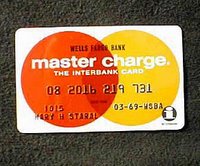 In 1967 a group of four California banks formed a new association entity called Master Charge (renamed MasterCard in 1979) which is now known as MasterCard International. This was done to compete with the BankAmericard (later became Visa in 1977). This new bankcard processing association would expand their services and increase their income potential, thus, these small banks formed a mutual relationships with large national or international banks. In 1967 a group of four California banks formed a new association entity called Master Charge (renamed MasterCard in 1979) which is now known as MasterCard International. This was done to compete with the BankAmericard (later became Visa in 1977). This new bankcard processing association would expand their services and increase their income potential, thus, these small banks formed a mutual relationships with large national or international banks.
In 1969 banks interested in issuing cards of their own, became members of either the Master Charge program (MasterCard Association) or BankAmericard program (Visa Association). This also means that most independent bank charge cards would now change over to either credit card programs. This was mutually beneficial to all banks and small financial institutions since, they shared card program costs. Both organizations issued credit cards through their member banks for their customers. Also, they both lay down standards for credit card processing.
In 1977 BankAmericard spreading its credit card business globally had difficulty achieving this due to the association of "America" in BankAmericard. Thus, its name was changed to Visa. This changing of name was followed shortly (2 years after) by Master Charge to Master Card.
In 1979 Master Charge changed its name to Master Card. Also, the electronic processing of credit cards improved through electronic dial-up terminals and magnetic stripes on the back of credit cards. This allowed consumers credit cards swiped by merchants to accessed issuing bank card holder information. This method decreased fraud, increased speed of processing authorizations and decrease the usage of paper.
 In the early 1980s the first Automatic Teller Machines (ATMs) came into existence. This gave credit card holders access to cash in different currencies from different countries around the world as well as locally. In the early 1980s the first Automatic Teller Machines (ATMs) came into existence. This gave credit card holders access to cash in different currencies from different countries around the world as well as locally.
ATMs give consumers the opportunity to have access to cash from their bank account or from their credit card. Also, this gives an extra benefit to card holders since they could make deposits 24 hours a day from most countries around the world.
2005 and beyond: Today, MasterCard, American Express, VISA, and Discovery, are the most popular and also have the most respected symbols when it comes to credit cards.
The credit card/payment system will continue to evolve as a new technology payment system developed through the advancement in science and technology . Read articles below Under the heading :Additional Info. On credit Card- “future credit cards” that are in the making for the near future. Only a few are listed but there are other bigger futuristic developments out there in the making.

Did You Know?
Antitrust Court Ruling:
- Recently (in 2004), a antitrust court ruling was initiated by American Express, Discover and retail giant Walmart against Visa and MasterCard. This court ruling changed the exclusive relationship that Visa and MasterCard have enjoyed with Banks over the years. This allow banks and credit card issuers to provide customers with all credit cards in addition to Visa or MasterCard.
According to CSLF :
- 55% of students obtain their first credit card during their first year of college.
- 33% of students have both student loan and credit card debt after college.
Sears Corp. and Discovery Card:
- Discover Card was originally part of the Sears Corporation but then decided to create a new brand with its own merchant network.
Additional Info. On credit Card
Future Credit Cards - New Invention:
Credit Card With Driver’s License - a new type of credit card an all in one.
Credit Card With Digitized Finger Print - credit card containing your finger print in a digitized format to identify you.
Educate Yourself on Credit Cards
Credit Card Basics | Eight Things You Should Know | Who's Looking at Your Credit Report | Facts About Credit Scoring | How many credit cards is too many? | Building a Good Credit History | What is a credit history? | General Information On Credit Card | Preventing Identify Theft |
Published Friday, November 18, 2005
 Animals come in many forms, sizes and shapes and are usually grouped together in the wild for different reasons. They may work together as a team to; gather food effectively and efficiently, for protection, grooming, raising of their young, for migration and to play. Sometime ago we looked at What animal sounds are called. This week we will move away from the essay articles and look on the names of animals in their respective groups in a list format. You can go through the list to see what you know, ponder over a few and learn the rest. For example, what are a group of giraffes called? or what are a group of owls called? Animals come in many forms, sizes and shapes and are usually grouped together in the wild for different reasons. They may work together as a team to; gather food effectively and efficiently, for protection, grooming, raising of their young, for migration and to play. Sometime ago we looked at What animal sounds are called. This week we will move away from the essay articles and look on the names of animals in their respective groups in a list format. You can go through the list to see what you know, ponder over a few and learn the rest. For example, what are a group of giraffes called? or what are a group of owls called?
 (This list may look distorted in IE) (This list may look distorted in IE)
ANIMAL GROUP (Collective Names)
Antelope: A herd of antelope
Ant: A colony or An army of ants
Ape: A shrewdness of apes
Baboons: A troop of baboons
Bacteria: A culture of bacteria
Badger: A cete of badgers
Bass: A shoal of bass
Bear: A sleuth or sloth of bears
Beaver: A colony of beavers
Bee: A swarm, grist or hive of bees
Bird: A flock, flight, congregation or volery of birds
Boar: A sounder of boars
Buffalo: A herd of buffalo
Buck: A brace or clash of bucks
Caterpillar: An army of caterpillars
Cat: A clowder or clutter of cats
Cattle: A herd or drove of cattle
Chicken: A brood or peep of chickens
Chicks: A clutch or chattering of chicks
Clam: A bed of clams
Cobra: A quiver of cobras
Cockroach: An intrusion of cockroaches
Colt: A rag of colts
Cow: A kine of cows (twelve cows are A flink)
Coyote: A band of coyote
Crane: A sedge or siege of cranes
Crocodile: A float of crocodiles
Crow: A murder of crows
Cub: A litter of cubs
Curlew: A herd of curlews
Cur: A cowardice of curs
Deer: A herd of deer
Dog: A pack of dogs
Donkey: A herd or pace of asses
Dove: A dule of doves
Duck: A brace, paddling or team of ducks
Elephant: A herd of elephants
Seal: A pod of elephant seals
Elk: A gang of elks
Emus: A mob of emus
Ferret: A business or flensing of ferrets
Finches: A charm of finches
Fish: A school, shoal, run, haul, catch of fish
Fly: A swarm or business of flies
Fox: A skulk or leash of foxes
Frog: An army or colony of frogs
Geese: A flock, gaggle or skein (in flight) of geese
Giraffe: A tower of giraffes/giraffe
Gnat: A cloud or horde of gnats
Goat: A herd, tribe or trip goats
Goldfince: A charm of goldfinches
Gorilla: A band of gorillas
Goldfish: A troubling of goldfish/goldfishes
Greyhound: A leash of greyhounds
Hare: A down or husk of hares
Hawk: A cast or kettle of hawks
Hen: A brood of hens
Heron: A hedge of herons
Hippopotamus: A bloat of hippopotamuses /hippopotami
Hog: A drift, or parcel of hogs
Horse: A team, pair or harras of horses
Hound: A pack, mute or cry of hounds
Jellyfish: A smack of jellyfish
Kangaroo: A troop or mob of kangaroos
Kitten: A kindle or litter of kittens
Lark: An ascension or exaultation of larks
Leopard: A leap (leep) of leopards
Lion: A pride of lions
Locust: A plague of locusts
Magpie: A tiding of magpies
Mallard: A sord of mallards
Mare: A stud of mares
Marten: A richness of martens
Mole: A labour of moles
Monkey: A troop of monkeys
Moose: A herd of moose
Mouse: A mischief of mice
Mule: A barren or span of mules
Owls: A parliament of owls
Otter: A romp of otters
Oxen: A yoke, drove, team or herd of oxen
Oyster: A bed of oysters
Parrot: A company of parrots
Partridge: A covey of partridges
Peacock: A muster, pride or ostentation of peacocks
Peep: A litter of peeps
Penguin: A colony,parcel or huddle of penguins
Pheasant: A nest, nide (nye) or bouquet of pheasants
Pigeon: A flock or flight of pigeons
Pig: A litter of pigs
Plover: A wing or congregation of plovers
Pony: A string of ponies
Porpoise: A pod of porpoises
Quail: A covey or bevy of quail
Rabbit: A nest of rabbits
Rat: A pack or swarm of rats
Rattlesnake: A rhumba of rattlesnakes
Raven: An unkindness of ravens
Rhino: A crash or herd of rhinos
Roebuck: A bevy of roebucks
Rook: A building or clamour of rooks
Seal: A herd or pod of seals
Sheep: A drove or flock of sheep
Snake: A nest of snakes
Snipe: A walk or wisp of snipe
Sparrow: A host of sparrows
Squirrel: A dray or scurry of squirrels
Starling: A murmuration of starlings
Stork: A mustering of storks
Swallow: A flight of swallows
Swan: A bevy, herd, lamentation or wedge of swans
Swift: A flock of swifts
Swine: A sounder or drift of swine
Teal: A spring of teal
Tiger: A swift or ambush of tigers
Toad: A knot of toads
Trout: A hover of trout
Turkey: A rafter of turkeys
Turtledove: A pitying or dule of turtledoves
Turtle: A bale of turtles
Walrus: A pod of walrus
Whale: A school, gam or pod of whales
Viper: A nest of vipers
Wolf: A pack or route of wolves
Woodcock: A fall of woodcocks
Woodpecker: A descent of woodpeckers
Zebra: A herd,zeal or dazzle of zebras
Related Articles:
The Names of Animals and their Youngs
Collective Nouns of People
What animal sounds are called
Some Animal Sites Of Interest
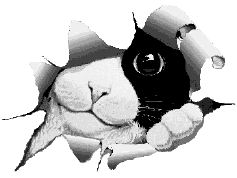
Animal Planet | Animal Diversity | Desert USA | National Geography
Published Friday, November 11, 2005
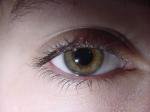 The human eye is a extremely sophisticated visual anatomical device ( sensory organ) architecturally designed elegantly and efficiently for its purpose. Our eyes are the window to this world that allow us to see its spectacular beauty. Through our eyes we see places, objects, friends, family, our own body, our pets and other living things around us. It allows us to see, interpret, make decisions and conclusions about things we see. Through our eyes we can tell if something is beautiful, ugly, colorful, dull, rough, smooth, glossy, bright, dark, transparent, as dimensions and so on. Also, it allows us to; learn from visual information, compare, contrast and make decisions. Our eyes serve as a protection device that protect us from harm by allowing us to make judgment or prediction of an object or event and to take the necessary action (response) of whether to fight or flee. Through our eyes we also communicate with each other and send message to others about our The human eye is a extremely sophisticated visual anatomical device ( sensory organ) architecturally designed elegantly and efficiently for its purpose. Our eyes are the window to this world that allow us to see its spectacular beauty. Through our eyes we see places, objects, friends, family, our own body, our pets and other living things around us. It allows us to see, interpret, make decisions and conclusions about things we see. Through our eyes we can tell if something is beautiful, ugly, colorful, dull, rough, smooth, glossy, bright, dark, transparent, as dimensions and so on. Also, it allows us to; learn from visual information, compare, contrast and make decisions. Our eyes serve as a protection device that protect us from harm by allowing us to make judgment or prediction of an object or event and to take the necessary action (response) of whether to fight or flee. Through our eyes we also communicate with each other and send message to others about our  present state. For example, we use our eyes to send a message to someone if we are in agreement with the action they are doing or about to do by blinking (winking) one of our eyes. We can also use ours eyes tell someone we are interested in them or you can receive a message if someone is interested in you.Through the eyes we can read messages about the persons state or mood present state. For example, we use our eyes to send a message to someone if we are in agreement with the action they are doing or about to do by blinking (winking) one of our eyes. We can also use ours eyes tell someone we are interested in them or you can receive a message if someone is interested in you.Through the eyes we can read messages about the persons state or mood  such as if they are; sad, tired, stressed, ill, drunk, frustrated, crying, happy, angry, surprised, depress, excited, sleepy and so on. Thus, like most people we depend on such as if they are; sad, tired, stressed, ill, drunk, frustrated, crying, happy, angry, surprised, depress, excited, sleepy and so on. Thus, like most people we depend on our eyes to carry out our busy daily activities but have you ever wondered or stop to think how incredible this wonderful and special designed organ allows you to see and also to read this article? Let's take a look on the anatomy and function of the eye to see how it works and also how important your vision is to you. our eyes to carry out our busy daily activities but have you ever wondered or stop to think how incredible this wonderful and special designed organ allows you to see and also to read this article? Let's take a look on the anatomy and function of the eye to see how it works and also how important your vision is to you.
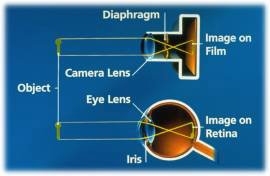 How the eye works can be compared to that of a simple camera. Like the eye, a camera creates images by focusing (using the cornea and lens) on an object by allowing certain amounts of light (reflected from the object) to pass through a hole ( iris and diaphragm) that adjusts the amount of light entering which then creates a visual impression (on the retina and on film). The light can originate directly either from the object (e.g. the sun, bulb) or in directly from an object (a chair, book, moon) by the reflected light from its surface. This explains why we can’t see in the dark. Darkness is the absent of light thus, there is no light reflected from the object to enter through our pupil to form an image on our retina in the eye. If there is light we are able to see the object depending on the amount of light present. The limited amount of light in a dark room for example, can also let us see things without colors giving a dull, dark, grayish appearance (see retina section on rods for reason, further down below). The colors we see when we look at objects are due to the light source and also from the light that is reflected from that object to the eye. How the eye works can be compared to that of a simple camera. Like the eye, a camera creates images by focusing (using the cornea and lens) on an object by allowing certain amounts of light (reflected from the object) to pass through a hole ( iris and diaphragm) that adjusts the amount of light entering which then creates a visual impression (on the retina and on film). The light can originate directly either from the object (e.g. the sun, bulb) or in directly from an object (a chair, book, moon) by the reflected light from its surface. This explains why we can’t see in the dark. Darkness is the absent of light thus, there is no light reflected from the object to enter through our pupil to form an image on our retina in the eye. If there is light we are able to see the object depending on the amount of light present. The limited amount of light in a dark room for example, can also let us see things without colors giving a dull, dark, grayish appearance (see retina section on rods for reason, further down below). The colors we see when we look at objects are due to the light source and also from the light that is reflected from that object to the eye.
Click All Image To Enlarge
 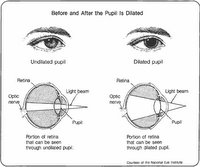 In order to see an object light must first come from the object or bounce off the surface of that object and then enter our eyes. When light reaches our eyes it enters through a transparent layer of tissue called the cornea (the window of the eye). The cornea, responsible for focusing, takes widely diverging rays of light reaching the eyes and converge (bends) them through the pupil. The pupil is the black-appearing round spot (opening) in the center of the colored iris that regulates how much light enters the eye by expanding and contracting its opening. For example, if you are in a room with low lighting, the pupil will expand to allow more light to enter, likewise, if the light is too bright, the pupil will contract (shrink) to allow more light to enter the eye in order to vision the surrounding. Here, the pupil prevent damage to be done to the eyes from excess light entering. You can try this with a friend, spouse or a family remember by staying in the dark for awhile then let some look at your pupil then repeat this the other way around by staying in a bright light or bright sun then let someone looks at your pupil. Do you ever feel a slight pain and temporary blindness when you ever move from a dark surrounding to a well lit surrounding? This happens because too much lights enters the eyes and the pupil quickly adjust the pupil size to limit the amount of light entering the eye - then that temporary blindness will then all go away. In order to see an object light must first come from the object or bounce off the surface of that object and then enter our eyes. When light reaches our eyes it enters through a transparent layer of tissue called the cornea (the window of the eye). The cornea, responsible for focusing, takes widely diverging rays of light reaching the eyes and converge (bends) them through the pupil. The pupil is the black-appearing round spot (opening) in the center of the colored iris that regulates how much light enters the eye by expanding and contracting its opening. For example, if you are in a room with low lighting, the pupil will expand to allow more light to enter, likewise, if the light is too bright, the pupil will contract (shrink) to allow more light to enter the eye in order to vision the surrounding. Here, the pupil prevent damage to be done to the eyes from excess light entering. You can try this with a friend, spouse or a family remember by staying in the dark for awhile then let some look at your pupil then repeat this the other way around by staying in a bright light or bright sun then let someone looks at your pupil. Do you ever feel a slight pain and temporary blindness when you ever move from a dark surrounding to a well lit surrounding? This happens because too much lights enters the eyes and the pupil quickly adjust the pupil size to limit the amount of light entering the eye - then that temporary blindness will then all go away.
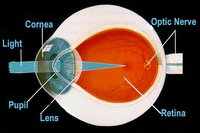
 When the light goes through the pupil it then passes through the lens, a transparent structure situated behind the pupil of the eye, then refract the incoming light and fine tune the focused light onto the retina. This it does by changing the focus of the light from distant objects by altering its shape. This change in focus is called accommodation. You can alter the focus of your lens by placing your finger in front of your face and slowly bringing your finger closer to eyes, right up to your nose then move it away again - there you have just altered your focus by altering the lens of your eyes. This focus light will then travel through the vitreous humour (a clear gel) that fills the central core of the eye and helps to maintain the eye spherical shape. When the light goes through the pupil it then passes through the lens, a transparent structure situated behind the pupil of the eye, then refract the incoming light and fine tune the focused light onto the retina. This it does by changing the focus of the light from distant objects by altering its shape. This change in focus is called accommodation. You can alter the focus of your lens by placing your finger in front of your face and slowly bringing your finger closer to eyes, right up to your nose then move it away again - there you have just altered your focus by altering the lens of your eyes. This focus light will then travel through the vitreous humour (a clear gel) that fills the central core of the eye and helps to maintain the eye spherical shape.
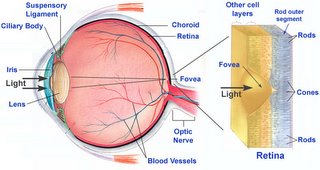 After leaving the lens and traveling through the vitreous humour it will then reach the retina which is at the back of the eye. The retina is a light-sensitive membrane lining the inner wall of the eyeball. This contains millions of photoreceptor nerve cells which react to the presence and intensity of the light image. There are two types of photoreceptors which are called rods and cones. [image here] The rods register shapes and respond to low levels of light which is responsible for night vision while, on the other hand, the cones register (detect) color and only work in bright light. This means when there is less light or as the evening becomes darker the cones will become less responsive and thus, it is more difficult to see colors. After leaving the lens and traveling through the vitreous humour it will then reach the retina which is at the back of the eye. The retina is a light-sensitive membrane lining the inner wall of the eyeball. This contains millions of photoreceptor nerve cells which react to the presence and intensity of the light image. There are two types of photoreceptors which are called rods and cones. [image here] The rods register shapes and respond to low levels of light which is responsible for night vision while, on the other hand, the cones register (detect) color and only work in bright light. This means when there is less light or as the evening becomes darker the cones will become less responsive and thus, it is more difficult to see colors.
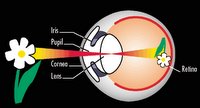 When the light image hits the retina an image will form upside down on its membrane surface containing the photoreceptors cells (light-sensitive cells). The image will then form upside down because the light rays cross while going through the cornea. This will then stimulate the photoreceptors cells (rods and cones) to change the light image into an electrochemical impulse (signals) which then travels along the optic nerve (bundle of retinal fibers )that exits the back of the eye to the vision center (occipital cortex) of the brain. Here the brain interprets the electrical signal and re-adjust the image upward allowing us to “see” the object. Hence, sight (vision) is achieved in the brain. When the light image hits the retina an image will form upside down on its membrane surface containing the photoreceptors cells (light-sensitive cells). The image will then form upside down because the light rays cross while going through the cornea. This will then stimulate the photoreceptors cells (rods and cones) to change the light image into an electrochemical impulse (signals) which then travels along the optic nerve (bundle of retinal fibers )that exits the back of the eye to the vision center (occipital cortex) of the brain. Here the brain interprets the electrical signal and re-adjust the image upward allowing us to “see” the object. Hence, sight (vision) is achieved in the brain.
Did You Know ?

- Human Eye Facts
- A newborn baby sees the world upside down because it takes some time for the baby's brain to learn to turn the image right-side up.
- The eye is the second most complex organ you possess after the brain.
- The average person blinks about 12 times a minute.
- Animal Eye Facts
- An ostrich which has eyes that are two inches across. Each eye weighs more than the brain. In other words, an ostrich's eye is bigger than its brain.
- An eagle can see a rabbit about 1 mile or 1760 yards away while average person needs to be about 550 yards away to see the same rabbit.
- The reason cat's and dog's eyes glow at night is because of a silver “mirrors” in the back of their eyes called the tapetum lucidum (meaning "bright carpet") which is a thick reflective membrane. This collects and re-emits light back to the retina a second time thus giving the light-sensitive cell (rods) a second opportunity to absorb the image information again. This a adaptation for night vision and makes it easier for them to see at night by maximizing the limited available light. Hence, the reflected light from the tapetum let the animal's eyes appear to glow in the dark.
Published Friday, November 04, 2005
 Most of us based on our geographical location might have seen large groups of geese migrating while flying in a V formation. Other of us might have only seen this in books or on the television. This formation can be seen when they migrate from their summer homes in Canada, around late fall (autumn) and early winter, to the warmer climate of the southern United States. You may have wondered why they choose this particular regular V-shaped formation pattern. Everything in nature is done for a particular reason even though we might not see the obvious reason for such. Nature teaches us a lot of things, and if we could only just take some time out of our daily busy schedule to ponder, learn and understand things around us whether it be an ant, a plant, a bird, our general surrounding and so on, we would be much more wiser individuals and leaders in this world. This article will therefore answer the question above and also quickly look at how we can learn and apply this natural phenomena to better our daily lives. Most of us based on our geographical location might have seen large groups of geese migrating while flying in a V formation. Other of us might have only seen this in books or on the television. This formation can be seen when they migrate from their summer homes in Canada, around late fall (autumn) and early winter, to the warmer climate of the southern United States. You may have wondered why they choose this particular regular V-shaped formation pattern. Everything in nature is done for a particular reason even though we might not see the obvious reason for such. Nature teaches us a lot of things, and if we could only just take some time out of our daily busy schedule to ponder, learn and understand things around us whether it be an ant, a plant, a bird, our general surrounding and so on, we would be much more wiser individuals and leaders in this world. This article will therefore answer the question above and also quickly look at how we can learn and apply this natural phenomena to better our daily lives.
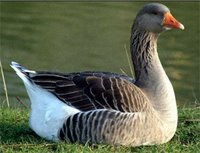 So, why do they fly in this particular formation? Over the years scientists have came up with theories of why migratory birds such as geese fly in a V-shaped formation. A study done sometime back also shed some light on this particular V formation. This study discovered that birds flying in a V format had lower heart rates than bird flying alone. Why? The aerodynamic V shape formation reduces the air drag (air resistance) that each bird experiences when in flight in comparison to a bird flying solo. This allows them to cover longer distance (thousands of miles) with much less effort. For example, geese can achieve a greater distance of about 70 percent when flying in groups than each flying solo, using the same amount of energy. In this formation, the bird in the lead position will experience a greater air resistance and will have to work a little harder, however, when the lead bird is tired it falls out of position and goes behind So, why do they fly in this particular formation? Over the years scientists have came up with theories of why migratory birds such as geese fly in a V-shaped formation. A study done sometime back also shed some light on this particular V formation. This study discovered that birds flying in a V format had lower heart rates than bird flying alone. Why? The aerodynamic V shape formation reduces the air drag (air resistance) that each bird experiences when in flight in comparison to a bird flying solo. This allows them to cover longer distance (thousands of miles) with much less effort. For example, geese can achieve a greater distance of about 70 percent when flying in groups than each flying solo, using the same amount of energy. In this formation, the bird in the lead position will experience a greater air resistance and will have to work a little harder, however, when the lead bird is tired it falls out of position and goes behind into one of the V position lines. Another bird from behind will then quickly move forward into the leading position thus, maintaining the V formation. The same happens for those birds in trailing positions especially those at both extreme ends of the V formation, since they tire more quickly than those in the middle. This cycle continues as they travel to their destination. Thus each bird gets the opportunity and responsibility to be in the lead position as well as enjoying the middle position since less air drag is at this position. This enjoyment of less air resistance comes as a result of the birds in front creating and improving the aerodynamics of the others behind which continues along the line of V. In other words, this formation breaks up the air, which then flows over the rest of the group more easily. This means all birds benefit individually while working harmoniously as a team. Working as a team means less work for each bird because flying requires a lot of energy especially for birds traveling a very long journey. This formation therefore help migratory birds such as the geese to use their energy efficiently and effectively to achieve one goal - to reach there destination. All members of the team plays their part and mutually benefits from this. How do they keep this formation? If a bird should shift out of position then that bird will suddenly feel the air drag of going solo and quickly get back into the line of formation. This demonstrates how team work plays a very important and useful role in nature. into one of the V position lines. Another bird from behind will then quickly move forward into the leading position thus, maintaining the V formation. The same happens for those birds in trailing positions especially those at both extreme ends of the V formation, since they tire more quickly than those in the middle. This cycle continues as they travel to their destination. Thus each bird gets the opportunity and responsibility to be in the lead position as well as enjoying the middle position since less air drag is at this position. This enjoyment of less air resistance comes as a result of the birds in front creating and improving the aerodynamics of the others behind which continues along the line of V. In other words, this formation breaks up the air, which then flows over the rest of the group more easily. This means all birds benefit individually while working harmoniously as a team. Working as a team means less work for each bird because flying requires a lot of energy especially for birds traveling a very long journey. This formation therefore help migratory birds such as the geese to use their energy efficiently and effectively to achieve one goal - to reach there destination. All members of the team plays their part and mutually benefits from this. How do they keep this formation? If a bird should shift out of position then that bird will suddenly feel the air drag of going solo and quickly get back into the line of formation. This demonstrates how team work plays a very important and useful role in nature.
There are other benefits of flying in this V position. Every bird in the group fly in the field of vision all other members. This helps in keeping track of each other in the group. This also makes it conducive to the members in the group to communicate with each other while in flight. For example, if one bird should become sick or has been injured by some means such as being shot, 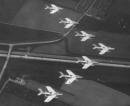 then, that bird will fall out of formation. This will then result in two other geese falling out with the wounded goose to help and offer protection and will remain until that bird recovers or dies before rejoining the others. It is important to note also that military jets fly in this V formation for the same reasons. Each fighter pilot can see, communicate and help each other while in flight working as a team. Also, NASCAR race car drafts another car to reduce the air resistance on their car. then, that bird will fall out of formation. This will then result in two other geese falling out with the wounded goose to help and offer protection and will remain until that bird recovers or dies before rejoining the others. It is important to note also that military jets fly in this V formation for the same reasons. Each fighter pilot can see, communicate and help each other while in flight working as a team. Also, NASCAR race car drafts another car to reduce the air resistance on their car.
Discussion:
 From this article we not only learn of the reason for the V formation of geese in flight but also learn the importance of team work that nature teaches us. This demonstrates that ‘No man is an island’. Time will not permit me to go through the article to explain in detail what can be learnt from this. However, it is self explanatory the social benefits that can evolve from us working together as a human race. There is a lot we can learn from nature if we only take the time to be more observant. We need to not only work together but support each other to achieve a common goal. Also, working as a team, encouraging and supporting each other lets us accomplish amazing goals with much less effort. “No man is an island”, and we do need each other for the human race to exist. All of us have a role to play in society and the world at large - “All for one and one for all”. From this article we not only learn of the reason for the V formation of geese in flight but also learn the importance of team work that nature teaches us. This demonstrates that ‘No man is an island’. Time will not permit me to go through the article to explain in detail what can be learnt from this. However, it is self explanatory the social benefits that can evolve from us working together as a human race. There is a lot we can learn from nature if we only take the time to be more observant. We need to not only work together but support each other to achieve a common goal. Also, working as a team, encouraging and supporting each other lets us accomplish amazing goals with much less effort. “No man is an island”, and we do need each other for the human race to exist. All of us have a role to play in society and the world at large - “All for one and one for all”.
To elaborate on this discussion you can read this excellent article on What geese have to do with lessons in leadership by Lt. Col. Molly J. Kusik - 11th Medical Operations Squadron commander.
Additional information and reading on geese:

Breeds of Geese - descriptions and pictures for several breeds.
Wikipedia - Information on Geese
Canada Goose - A website with some information on Canada Goose.
True Geese of the World: The Anser Species
Canada Geese - a site about Canada Geese.
 Fast facts on goose - Did you know? Fast facts on goose - Did you know?
- An adult goose eats up to 4 lbs of grass daily.
- Life Span of up to 24 years.
- Domestic breeds of geese are not generally capable of flight.
- Mating is for life. If a mate is lost, a new mate is often found.
- Geese mix and interbreed with all other types of geese.
- Geese generally return to their same nesting and birth place every year.
- An adult goose drops 2 lbs of fecal matter daily.
- Eggs are laid in March/ or early April - a group of eggs are called a clutch.
- Incubation period is 25 to 30 days.
- Baby Geese are called Goslings.
- Nests are built from twigs, bark, grasses and lined with soft feathers usually on the ground near water.
|
|
Message Board
FeedBack Appreciated
Please spare some time to give your feedback about this site. Thanks in advance.
|
|
|
|
Message from the Author
 R. Edmondson
United States
R. Edmondson
United States
Did You Know site is used as a learning tool to provide a stimulating learning environment for general knowledge development; to promote increased diversity on the online learning community and to incorporate the site’s informative quality content with the best of online communication platform (blog) in making knowledge accessible and free to all.
Thanks for the support.
|
|
|
|
|
 Credit card is one of the biggest inventions in this modern retail consumer society and a great advancement in the payment technology of the banking system since the invention of money. A tool that is very essential to the success and existence of any merchant whether it is a internet business , a physical store or both. Most people today carry a credit card for the convenience of not carrying cash, it is less bulky and light while others do so because of the purchasing power they have in their possession which they would not have had otherwise. Credit cards allows anyone to purchase any item that they desire (depending on their credit limit ) that they would not able to afford upfront.
Credit card is one of the biggest inventions in this modern retail consumer society and a great advancement in the payment technology of the banking system since the invention of money. A tool that is very essential to the success and existence of any merchant whether it is a internet business , a physical store or both. Most people today carry a credit card for the convenience of not carrying cash, it is less bulky and light while others do so because of the purchasing power they have in their possession which they would not have had otherwise. Credit cards allows anyone to purchase any item that they desire (depending on their credit limit ) that they would not able to afford upfront.  Credit cards are well engineered for minimum thickness which results in it being light and less bulky, it can easily fit in a wallet (bill fold), purse, pocket or any other personal. It can also easily fit with other similar sized documents such as medical card and drivers license. So, have you ever stopped to think about the evolution of your credit card? I guess you did not. Well this article will explain the evolution of this “cash on plastic” that confidently let you purchase stuff without no money (cash) in your pocket.
Credit cards are well engineered for minimum thickness which results in it being light and less bulky, it can easily fit in a wallet (bill fold), purse, pocket or any other personal. It can also easily fit with other similar sized documents such as medical card and drivers license. So, have you ever stopped to think about the evolution of your credit card? I guess you did not. Well this article will explain the evolution of this “cash on plastic” that confidently let you purchase stuff without no money (cash) in your pocket.

 In 1967 a group of four California banks formed a new association entity called Master Charge (renamed MasterCard in 1979) which is now known as MasterCard International. This was done to compete with the BankAmericard (later became Visa in 1977). This new bankcard processing association would expand their services and increase their income potential, thus, these small banks formed a mutual relationships with large national or international banks.
In 1967 a group of four California banks formed a new association entity called Master Charge (renamed MasterCard in 1979) which is now known as MasterCard International. This was done to compete with the BankAmericard (later became Visa in 1977). This new bankcard processing association would expand their services and increase their income potential, thus, these small banks formed a mutual relationships with large national or international banks. In the early 1980s the first Automatic Teller Machines (ATMs) came into existence. This gave credit card holders access to cash in different currencies from different countries around the world as well as locally.
In the early 1980s the first Automatic Teller Machines (ATMs) came into existence. This gave credit card holders access to cash in different currencies from different countries around the world as well as locally.
























 R. Edmondson
United States
R. Edmondson
United States













































